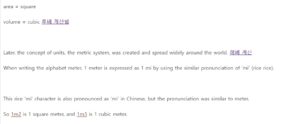Roubaix is volume (m3)
Hebe means area (m2).
1 lube
– A volume of 1 meter in width, length and height (width x length x height)
It means 1 cubic meter.
1 Hebe
– Area of 1 meter in width and length (width x length)
It means 1 square meter.
So, why are volume and area called Roubaix and Hebe?
Why are they called Roubaix and Hebe?
It was the first time in the East to express the concept of area and volume in Chinese characters.
area = square
volume = cubic 루베 계산법
Later, the concept of units, the metric system, was created and spread widely around the world. 헤베 계산
When writing the alphabet meter, 1 meter is expressed as 1 mi by using the similar pronunciation of ‘mi’ (rice rice).
This rice ‘mi’ character is also pronounced as ‘mi’ in Chinese, but the pronunciation was similar to meter.
So 1m2 is 1 square meter, and 1m3 is 1 cubic meter.
shorten this
m2 (square meters) = flat rice 인생꿀팁
m3 (cubic metres) = It has become a mouthful.

Now moving to Japan
m3 became Roubaix and m2 became Hebe.
In other words, roube and hebe are Japanese terms for volume and area.
Additionally, among the terms we use a lot in real life, tool-ri (concrete) and dan-dori (finish) can be cited as examples.
Today, we learned about the meaning and calculation method of Lube and Hebe.
Since the language is a Japanese expression, it would be better to use cubic meters & square meters instead of rube and hebe in the future.
If my article was helpful, please share.
then hello
[Source] Louwe Hebe Calculation Method, Term Meaning, and Origin | Author Digitalnomah